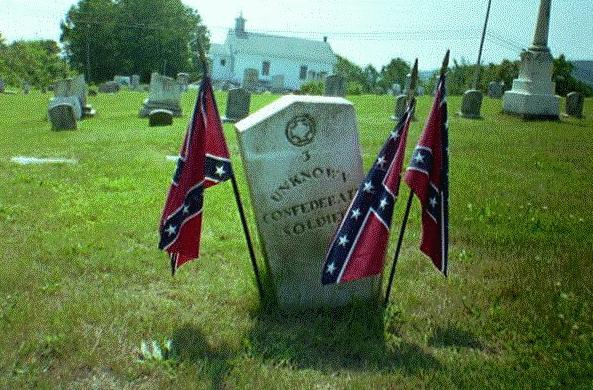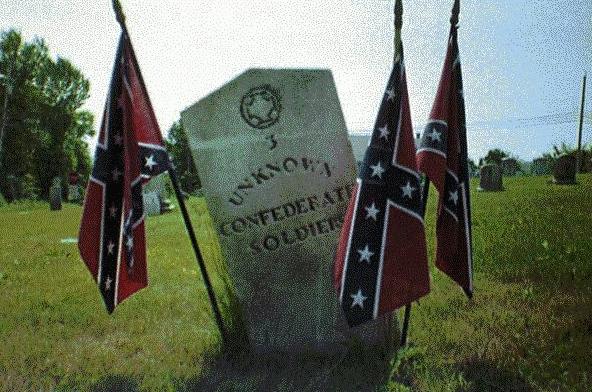

Study Areas
Confederate Burials In the Furnace Church Cemetery, Manada Furnace

Photo by George F. Nagle
Among the aged tombstones in the cemetery across the road from the Manada United Christian Church in East Hanover Township is one with the distinctive pointed arch commonly found on markers used for those who fought for the Confederate States of America. The stone bears no names to identify those buried beneath it, only the inscription “3 Unknown Confederate Soldiers.” It sits apart from the other graves, toward the rear of the small cemetery. Unlike the majority of the other gravestones, it faces away from the church. Surrounding the gravestone, which has acquired a pronounced leftward lean through the passing years, are three small and faded Confederate flags; proof that someone has taken it upon themselves to memorialize the site in recent times.
East Hanover Township is many miles away from the nearest Civil War battle site, and it does not lie close to the line of retreat which General Robert E. Lee’s Army of Northern Virginia used to retire from Pennsylvania after its disastrous invasion in late June of 1863. How, then, did these three southern soldiers come to their final resting place in such a seemingly unlikely location?
According to local historian LeRoy Lingle, of East Hanover Township, the Confederate soldiers were prisoners-of-war from Harrisburg’s Camp Curtin, who were being used as laborers at the nearby Manada Furnace, a local industry located along Manada Creek. Apparently the furnace owners, the Grubb family, used prisoners as wood cutters to feed the busy furnace that turned out many tons of pig iron. The soldiers lived near the furnace in wooden shacks, according to Lingle, and died while the war was still raging. He believes that they died at about the same time, and that their burial site is only the most well known of local Confederate burials. Up to a dozen more prisoners, he says, are buried near the original site of the worker’s shacks, the stone foundations of which can still be seen. Still more Confederates may be buried near the Old Hanover Cemetery only a few miles away. All died during the war, before they could be released to return home. This explanation has been corroborated by other local historians.
The cemetery in which the three unknowns are buried was originally the burial ground for the “Furnace Church,” or the Manada Furnace Methodist Episcopal church which the Grubbs built a short distance away for the convenience of their furnace work force, which usually numbered about 75 men. It was on the Hummelstown Episcopal Circuit as early as 1854, and was active during the Civil War, when the three unknown Confederates were interred in its cemetery. According to Mrs. Seaman Lingle, who is quoted in an undated newspaper article, the church was built in 1843 by her great-great uncle, John Care. Sometime after the furnace ceased operations in 1875 the church became vacant. In 1949 the building was sold to the Manada United Christian Church.
All other details about the Confederate laborers remain scarce. Their names, cause of death, and dates of death are all mysteries. One story tells of a furnace explosion that killed the three unidentified soldiers. Another story claims yellow fever claimed up to 15 Confederate laborers. Small pox is mentioned in yet a third story. If they did all die at about the same time, then disease is a plausible explanation, rather than one catastrophic explosion. If they had all died in an explosion, then it would probably also be likely that they would all have been buried together, rather than in different locations.
An explanation often given for the soldier’s lack of identity is that they were deserters from the Confederate Army, and wished to remain anonymous. This is a less likely explanation, as the Confederate prisoners at Camp Curtin were all considered prisoners-of-war, and no distinction was made as to the circumstances of their capture. It is likely that the Confederate soldiers were from the lot which arrived in Harrisburg in July, 1863, following the battle of Gettysburg. Over a thousand Confederate P.O.W.s inundated the camp, severely taxing its capacity to care for them. Prior to that, Confederate soldiers had been temporarily held in Camp Curtin as early as June of 1862, usually for only a matter of days until they could be sent to Fort Delaware, near Wilmington.
It is curious that the owners of Manada Furnace were able to get Confederate prisoners out of Camp Curtin for use as woodcutters and laborers. Harrisburg was intended to be only a temporary stop for the southerners, who were supposed to be sent north to regular prison camps. Perhaps the demands of the war for pig iron, combined with a possible manpower shortage in the area of East Hanover, led to the decision to use the prisoner’s labor. The area had contributed over 160 men in September of 1861 to form Company “D” of the 46th Pennsylvania Volunteer Infantry. This unit, composed mostly of workers from Manada Furnace, served until July, 1865.
Perhaps some day we will know the names of those three Confederate soldiers who lie beneath the marker in that old cemetery. In the meantime their stone stands as a reminder of the troubling and often chaotic events that found their way to the peaceful hills of this Dauphin County community.

Photo by George F. Nagle
Directions To The Manada United Christian
Cemetery Located
At The Intersection Of Ridge Road and Manada Gap Road
East Hanover Township, Dauphin County
From the Harrisburg area:
Take I-81 North to the Grantville/Hershey--Route 743 exit, turn left onto Rte. 743 N. Drive for .2 mile to Station Road. Turn left onto Station Road, which is just past the Holiday Inn on the left. Follow Station Road for 1.1 miles to the STOP sign which is at the intersection with Ridge Road. Turn left on Ridge Road and follow it for .8 mile to the STOP sign. Stay on Ridge Road for another .2 mile to the STOP EXCEPT RIGHT TURN sign, which is the intersection with Manada Gap Road. Turn right on Manada Gap Road and immediately left into the church parking lot. The cemetery is across Manada Gap Road. The Confederate graves are marked by a single stone, located about 2/3rds to the rear of the cemetery.
Article by George F. Nagle
This article originally appeared in The Bugle, the newsletter of the Camp Curtin Historical Society.
